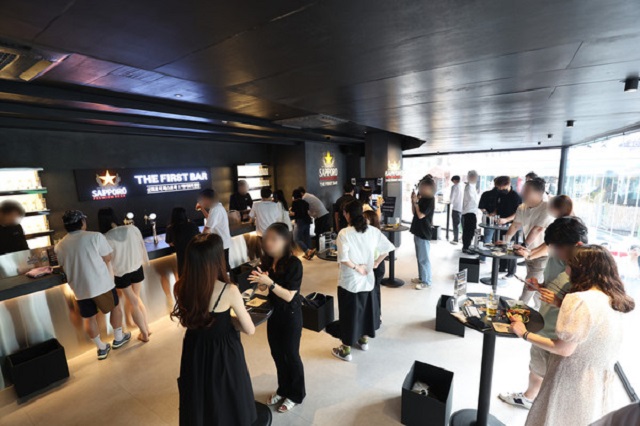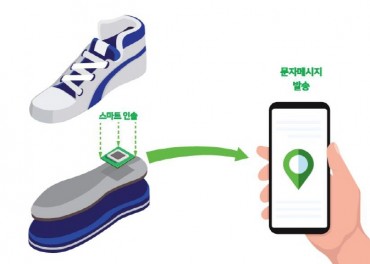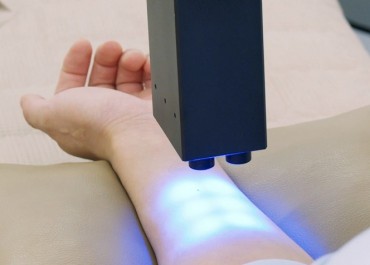
“Sapporo Premium Beer The First Bar,” Sapporo Breweries Ltd.’s first pop-up store in Seoul is seen in this photo provided by the Japanese beer brand.
SEOUL, July 3 (Korea Bizwire) — Japanese products are making significant strides in the imported beer market.
Previously, Japanese beers experienced a significant decline in market share due to product boycotts, allowing Chinese and Dutch beers to claim the top two spots for the last couple of years.
The popularity of Japanese beer is evident through the success of the “Sapporo The First Bar” (Sapporo Premium Beer First Bar), a Sapporo pop-up store that recently opened near KT&G Sangsang Madang in the Hongdae district of Seoul, a popular spot for members of Generation MZ.
This establishment aims to showcase the most delicious Sapporo premium beer in South Korea and has been attracting a steady stream of visitors, even on weekdays.
To ensure the proper presentation of the two versions of Sapporo Premium Beer at the pop-up store, a Japanese beer master was brought in to train the staff. The store will operate until July 23.
According to the Korea Customs Service, South Korea’s total beer imports last year amounted to 254 billion won (US$193 million), reflecting a 12.5 percent decrease compared to the previous year.
However, imports of Japanese beer more than doubled during the same period, reaching around 18.8 billion won.
From January to May of this year, imports of Japanese beer totaled 14.8 billion won, already achieving 80 percent of last year’s level.
Asahi, the leading brewery, has been expanding its supply chain following a recent period in which it struggled to keep its products in stock.
The company introduced the limited-quantity Asahi Superdry Draft Beer Can in May, known for its top that opens fully.
Due to its immense popularity, the new product will enter the entertainment market alongside draft and bottled beer starting in July.
Japanese beer slipped to third place in terms of market share in 2019, which was a result of the significant decline that began with a general boycott of Japanese products and services in 2019 as a result of a trade dispute.
Previously, Japanese beer held the top position in terms of import value until 2018.
The success of Japanese beer has put pressure on Chinese beer brands, which held the top spot for imported beer last year, leading them to seek alternative strategies.
Tsingtao Beer, a prominent Chinese beer brand, has been engaging in marketing activities to increase consumer engagement.
Tsingtao recently launched a new product called “Tsingtao Non-Alcoholic Lemon” and enlisted K-pop star Taeyeon as a brand ambassador for marketing in Hong Kong, Macau, Singapore, and Vietnam.
Dutch brewer Heineken is also focusing on providing experiential opportunities for consumers. The brewer collaborated with coworking space FastFive and a university to host a Heineken 0.0 sampling event last month.
Furthermore, Heineken operated a restaurant/pub bar zone and a home bar zone at the Seoul International Liquor & Wine Fair this month to offer tastings.
In comparison to last year, Korea imported around 43.6 billion won worth of Dutch beer, experiencing a decrease of approximately 13 billion won.
Meanwhile, the prolonged depreciation of the yen has led to a surge in Japanese direct sales.
According to Statistics Korea, in the first quarter of this year, the value of direct purchases of Japanese goods through online shopping portals reached 201.7 billion won, reflecting a 29.1 percent increase compared to the same period last year (approximately 92.9 billion won).
This figure also shows a 64.7 percent increase compared to the first quarter of 2021 (72.9 billion won), and marks the second consecutive quarter with revenue in the 120 billion won range, following the highest quarterly revenue ever recorded in the fourth quarter of last year.
Analysts attribute this trend to the prolonged depreciation of the yen, which has made Japanese products relatively more affordable, leading to a broader customer base opting for direct-to-consumer purchases.
M. H. Lee (mhlee@koreabizwire.com)







